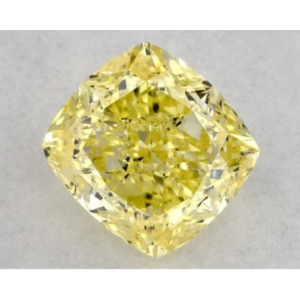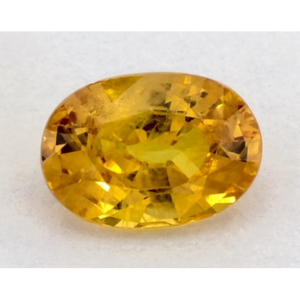Yellow Diamond and Yellow Sapphire are popular choices in jewelry, each offering unique advantages. This comprehensive comparison highlights their hardness, brilliance, color intensity, and value differences to help you decide which gemstone best suits your needs. Understanding their distinct qualities for an engagement ring or a custom piece ensures a beautiful and lasting selection.
|
|
Yellow Diamond Vs Yellow Sapphire: A Comparative AnalysisGo To Table of Contents |
| Attribute | Yellow Diamond | Yellow Sapphire |
|---|---|---|
| Physical Properties |
|
|
| Chemical Properties |
|
|
| Price Range |
|
|
| Type of Jewelry |
|
|
| Availability in Nature |
|
|
| Lab-Created vs Natural |
|
|
Table Of Contents
- 1) What Is The Difference Between Yellow Sapphire And Yellow Diamond
- 1.a) Hardness Comparison Between Canary Diamonds And Yellow Sapphires
- 1.b) Sparkle And Brilliance Of Yellow Sapphire Versus Yellow Diamond
- 1.c) Carat Weight And Color Intensity Comparison
- 1.d) Yellow Sapphire Versus Yellow Diamond For Diamond Engagement Rings
- 1.e) Canary Diamonds And Sunshine Sapphires In Different Jewelry Settings
- 2) How Do You Choose Between Yellow Sapphire And Yellow Diamond For Jewelry
- 2.a) Using The Mohs Scale Of Hardness To Determine Suitability
- 2.b) Understanding The Color Intensity And Hue
- 2.c) Finding The Perfect Yellow Stone
- 2.d) Considering The Carat Weight And Value For Lemon Sapphire And Canary Diamond
- 2.e) Expert Advice From Gemologists And Jewelers On Selecting Between Canary Diamonds And Sunshine Sapphires
- 3) Are There Any Specific Considerations For Yellow Diamond And Yellow Sapphire In Jewelry Making
- 3.a) The Process Of Setting Canary Diamond And Lemon Sapphires In Jewelry
- 3.b) Customization And Design Options
- 3.c) Comparison Of Yellow Sapphire And Yellow Diamond In Yellow Gold Jewelry
- 3.d) Synthetic Sapphires And Synthetic Diamonds As Alternatives
- 3.e) Wearing And Maintaining Jewelry
- 4) What Are The Gemological And Industry Aspects To Consider Between Yellow Sapphire And Yellow Diamond
- 4.a) Expert Insights From The Gemological Institute Of America
- 4.b) Understanding The Perceived Value And Cost Differences
- 4.c) Evaluating The Market Trends And Availability Of Yellow Sapphire And Yellow Diamond
- 4.d) Comparison In Terms Of Rarity And Exclusivity
- 4.e) Distinguishing Between Natural And Synthetic Yellow Sapphires And Yellow Diamonds
- 5) Yellow Diamond Vs Yellow Sapphire: A Tabulated Comparative Analysis
GIA 0.38 Carat Cushion Modified Fancy
|
1.06 Carat Oval Natural Yellow Sapphire
Click On the Image To Explore this stunning sapphire!
|
|
|
1) What Is The Difference Between Yellow Sapphire And Yellow DiamondBack To Top |
Yellow diamonds and yellow sapphires differ in composition, hardness, and brilliance. Diamonds, made of pure carbon, are the hardest natural gemstones and have unmatched sparkle. Sapphires, composed of corundum, are slightly softer but offer rich, consistent color at a more affordable price.
|
|
1.a) Hardness Comparison Between Canary Diamonds And Yellow SapphiresBack To Top |
Yellow sapphires whisper of durability, scoring a respectable nine on the Mohs scale. They stand tough against scratches, making them a fine choice for daily wear. On the flip side, yellow diamonds boast a perfect 10, clinching the title of the hardest gemstones.
14K Yellow Gold Fancy Yellow Cushion Cut Diamond Eternity Ring |
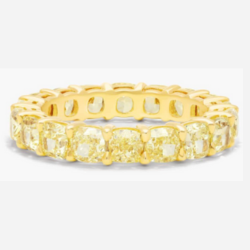
|
| Click on the Image |
The high level of hardness means they’re not just glimmering with color but also with an enduring spirit that resists the trials of time and wear. In the dance of durability, yellow diamonds take a slight bow, offering a little extra assurance against life’s knocks and bumps.
Impact of Hardness on Daily Wear and Longevity
While both gemstones are durable, hardness affects how well they hold up over time. Yellow sapphires, though resilient, may develop slight surface wear with prolonged use, giving them a more muted finish.
Yellow diamonds, being the hardest gemstone, maintain their polished brilliance for generations, making them excellent choices for heirloom jewelry.
Toughness vs. Hardness: Understanding the Difference
Hardness determines scratch resistance, but toughness measures a gemstone’s ability to resist chipping or breaking. Despite their superior hardness, diamonds have cleavage planes that make them vulnerable to chipping under direct impact.
Yellow sapphires, though slightly softer, have greater structural toughness, making them less likely to crack if struck.
Best Jewelry Settings for Each Gemstone
Hardness plays a key role in choosing jewelry settings. Yellow diamonds, highly resistant to scratches, are perfect for rings that endure frequent contact with surfaces.
Yellow sapphires, while durable, are more suited for earrings, pendants, and bracelets where they are less exposed to daily wear and potential damage.
Yellow Sapphire Eternity Necklace in 14k Yellow Gold |
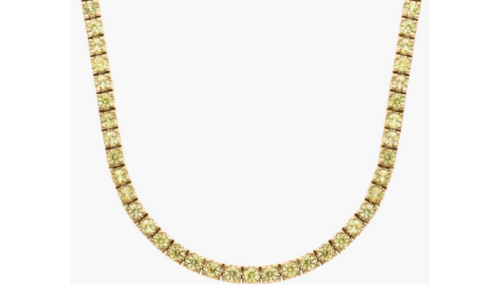
|
| Click On The Image To Embrace The Warm Glow Of These Glorious Yellow Sapphires |
Maintenance and Cleaning Considerations
Despite their resilience, both gemstones require regular care. Diamonds tend to attract oils and grime, which dull their brilliance over time. A simple cleaning routine with mild soap and warm water restores their sparkle.
Yellow sapphires resist smudging better but should also be cleaned periodically to maintain their vibrant glow.
|
|
1.b) Sparkle And Brilliance Of Yellow Sapphire Versus Yellow DiamondBack To Top |
When it comes to sparkle, yellow diamonds are the life of the party. Their refractive index makes them a beacon of light, turning heads with their fiery brilliance. Yellow sapphires, while not as flashy, have their subtle charm. They carry a glow that’s warm and inviting, with a brilliance that’s gentle yet captivating. Each stone tells its own story with light: diamonds with a bold statement, sapphires with a soft sonnet.
Refractive Index: Why Diamonds Sparkle More
The secret behind a gemstone’s sparkle lies in its refractive index, which determines how much light bends within the stone. Yellow diamonds have a refractive index of 2.42, allowing them to reflect and refract light with exceptional brilliance. This creates the dazzling flashes of white and colored light known as fire.
14K Yellow Gold Fancy Yellow Oval Cut Diamond Eternity Ring Prong Setting |
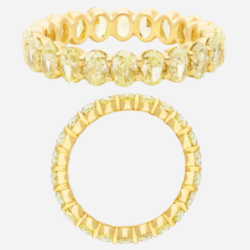
|
| Click On The Image To Experience The Dazzling Allure Of These Yellow Diamonds |
In contrast, yellow sapphires have a refractive index of 1.76, meaning they return less light and appear softer in their glow. While they don’t exhibit the same fiery dispersion as diamonds, their depth of color and subtle shimmer make them equally appealing in a different way.
Brilliance vs. Luster: Understanding the Glow
The way a gemstone interacts with light affects its overall visual appeal, with brilliance and luster playing distinct roles. Brilliance refers to how much light bounces back from inside the stone, creating a bright and lively appearance. Diamonds excel in brilliance due to their ability to reflect nearly all incoming light.
Luster, on the other hand, describes how light interacts with the gem’s surface. Diamonds have an adamantine luster, which gives them their signature high-gloss shine. Yellow sapphires possess a vitreous luster, which is softer and more glass-like, lending them a gentler, more understated glow.
The Role of Cut in Enhancing Sparkle
The way a gemstone is cut significantly affects its ability to reflect light. Yellow diamonds, especially those with excellent faceting, maximize brilliance by directing light back to the eye. Popular cuts like the round brilliant, cushion, and radiant enhance their light performance.
Yellow sapphires, being less reflective, are often cut deeper to enrich their color. While faceting does help with light return, sapphires are prized more for their saturation than for their sparkle. For those who prefer a brighter stone, opting for a well-cut yellow diamond is the best choice. If warmth and color depth are more appealing, a sapphire is ideal.
Yellow Sapphire Tennis Bracelet in 14k Yellow Gold (2mm) |
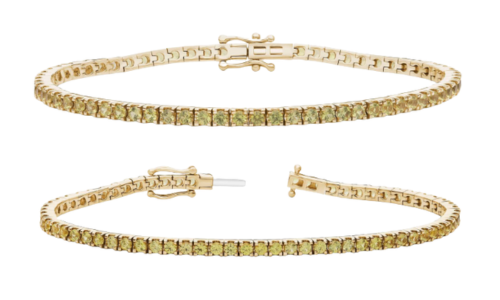
|
| Click On The Image To Delve Into The Rich Hues Of These Captivating Yellow Sapphires |
Best Jewelry Settings for Maximum Brilliance
The right setting can enhance a gemstone’s sparkle by allowing more light to interact with it. Yellow diamonds shine best in open settings such as prong or halo styles, which maximize light entry and reflection. White gold or platinum settings can further amplify their brilliance by providing contrast.
Yellow sapphires, with their rich golden hues, work beautifully in bezel or vintage-inspired settings that emphasize depth of color. Pairing them with yellow gold enhances their warm tones, creating a luxurious and timeless look.
|
|
1.c) Carat Weight And Color Intensity ComparisonBack To Top |
In carat weight and color intensity, yellow sapphires and diamonds tell two different tales. Sapphires often come in heftier sizes without making wallets weep. Their color, a saturated sunshine hue, remains consistent across various sizes. Yellow diamonds, however, are a rarer breed. As carat size increases, so does their value—exponentially. The most sought-after shade? A vivid, canary yellow, which is as rare as it is enchanting.
How Carat Weight Affects Pricing
Carat weight plays a critical role in gemstone pricing, but its impact differs between yellow diamonds and yellow sapphires.
Sapphires offer a more gradual price increase with size, meaning larger stones remain relatively affordable compared to diamonds. A five-carat yellow sapphire can cost significantly less than a one-carat fancy vivid yellow diamond.
Yellow Cushion-Cut Diamond Halo Ring in Platinum and 18k Yellow Gold |
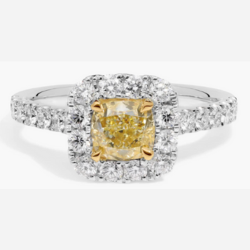
|
| Click On The Image To Tap To Reveal The Radiant Beauty Of This Yellow Diamond |
In contrast, yellow diamonds experience an extreme price jump with increasing carat weight due to their rarity. The difference becomes even more pronounced in fancy vivid yellow diamonds, where demand far outpaces supply.
The Influence of Color Intensity on Value
The intensity of color significantly affects a gemstone’s worth. Yellow sapphires maintain consistent saturation across various sizes, allowing buyers to obtain richly colored stones without dramatic price fluctuations.
However, yellow diamonds follow a strict grading scale, with fancy light, fancy, fancy intense, and fancy vivid categories determining their market value. The deeper and more saturated the yellow, the rarer and more valuable the diamond becomes. Fancy vivid yellow diamonds, with their intense golden hues, command the highest premiums, especially in larger carat sizes.
Understanding Market Trends and Rarity
Market availability also impacts the carat-to-price ratio of both gemstones. Yellow sapphires, being more abundant, can be found in larger sizes without a significant supply constraint.
In contrast, large yellow diamonds, particularly those exceeding three carats with fancy vivid color, are exceptionally rare. The closure of key diamond mines has further tightened the supply of high-quality fancy-colored diamonds, making canary diamonds even more exclusive. Investors and collectors often seek out these diamonds for their strong appreciation potential in the luxury market.
Choosing the Right Carat and Color Balance
For buyers balancing size, color, and price, understanding these factors is crucial. Those who prioritize size over rarity may lean toward yellow sapphires, as they offer larger carat weights without excessive cost.
On the other hand, buyers seeking exclusivity, high value, and resale potential may opt for a smaller yet intensely colored fancy vivid yellow diamond. Each gemstone presents its own appeal, making the choice a matter of personal preference and investment strategy.
|
|
1.d) Yellow Sapphire Versus Yellow Diamond For Diamond Engagement RingsBack To Top |
Engagement rings whisper promises of forever. Yellow sapphires bring a touch of the unique without straying too far from tradition. They symbolize wisdom and prosperity, suitable for those seeking a ring with a story. Yellow diamonds, however, are a splurge of luxury—a statement of commitment as strong as the stone itself. They sparkle with an unmatched intensity, perfect for those who want to dazzle with every gesture.
Riviera Pave Yellow Sapphire Eternity Ring in 18k Yellow Gold (1.5mm) |
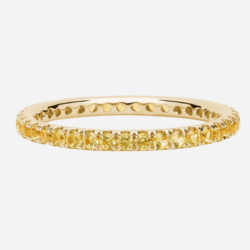
|
| Click On The Image To Experience The Enchanting Charm Of These Exquisite Yellow Sapphires |
Durability and Longevity in Engagement Rings
A gemstone’s durability plays a crucial role in engagement rings, which endure daily wear. Yellow diamonds, rated at 10 on the Mohs scale, offer unmatched hardness and scratch resistance, making them ideal for a lifetime of use.
Yellow sapphires, with a rating of 9, also provide excellent durability but may require slightly more care to prevent minor abrasions over time. Both gemstones are well-suited for engagement rings, but diamonds have a slight edge in long-term wearability.
Symbolic Meanings and Emotional Appeal
Beyond aesthetics, gemstones carry deep symbolic meanings. Yellow sapphires, associated with wisdom, abundance, and positive energy, make meaningful engagement rings for those who value spiritual significance.
Yellow diamonds, representing wealth, prestige, and unbreakable love, appeal to those who see their engagement ring as a bold statement of commitment. Choosing between the two depends on whether one prioritizes personal symbolism or luxurious impact.
Customization and Ring Setting Choices
The choice of gemstone influences the best setting options. Yellow diamonds thrive in prong and halo settings, which maximize their brilliance and enhance their fire. White or platinum metals contrast beautifully with their golden hue, amplifying their vibrancy.
7-Stone Radiant-Cut Yellow Diamond Ring in 18k Yellow Gold |
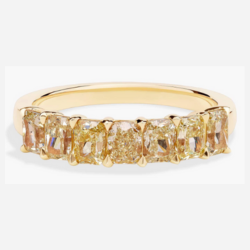
|
| Click On The Image To Discover The Unmatched Sparkle Of These Exquisite Yellow Diamonds |
Yellow sapphires, with their rich color depth, pair well with bezel or vintage-inspired settings that highlight their warmth. Both stones work well in yellow gold, creating a cohesive and elegant look.
Investment Value and Affordability
Pricing differences between yellow sapphires and yellow diamonds can be significant. Yellow sapphires offer an affordable way to own a colored gemstone engagement ring without sacrificing durability or beauty. Their price increases steadily with size and quality but remains far below that of yellow diamonds.
In contrast, yellow diamonds, particularly fancy vivid shades, appreciate in value over time due to their rarity, making them an investment-worthy choice for those looking beyond aesthetics.
|
|
1.e) Canary Diamonds And Sunshine Sapphires In Different Jewelry SettingsBack To Top |
In the theater of jewelry settings, yellow sapphires and diamonds play their roles with grace. Sapphires, with their robust character, fit nicely into a variety of settings—from vintage-inspired to modern minimalism. They pair charmingly with both white and yellow metals . Yellow diamonds, the stars of the show, demand settings that secure and showcase their brilliance, like a halo that amplifies their natural radiance. Each gem finds its stage, ready to shine in the spotlight of admiration.
Choosing the Right Setting for Durability
Durability plays a key role in selecting a jewelry setting, especially for pieces you plan to wear daily. Yellow diamonds, with their exceptional hardness, perform well in open settings like prongs, which allow maximum light exposure for increased brilliance. A four- or six-prong solitaire setting not only highlights the diamond but also keeps it secure.
For yellow sapphires, which are slightly softer, a bezel setting offers extra protection, especially for rings and bracelets exposed to frequent contact. If you prefer an open setting for a sapphire, consider a half-bezel, which provides security while allowing more light to interact with the stone.
Orange Sapphire Eternity Necklace in 14k Yellow Gold (2mm) |
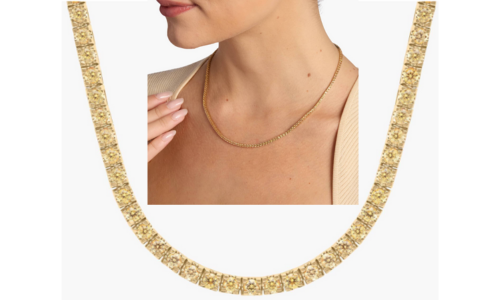
|
| Click On The Image To Discover The Timeless Beauty Of This Radiant Orange Sapphire |
Best Metal Choices for Yellow Gemstones
The metal setting influences how a gemstone’s color appears. Yellow gold enhances the warm undertones of both canary diamonds and sunshine sapphires, creating a seamless, monochromatic look. White gold and platinum provide a striking contrast, making the gemstone’s yellow hues appear more vivid and defined.
Rose gold, a softer alternative, brings out the golden warmth of yellow sapphires while adding a romantic, vintage appeal. The right metal choice also depends on your style—whether you want a classic, bold, or delicate look.
Enhancing Brilliance and Fire in Jewelry Designs
Certain settings can amplify a gemstone’s natural beauty. Yellow diamonds, known for their fire and brilliance, shine best in halo or pavé settings that reflect light from multiple angles. A halo of smaller diamonds can create an illusion of greater size, making a yellow diamond appear even more impressive. Pavé settings, where tiny diamonds are set closely together, add a shimmering effect that enhances the main stone’s brilliance.
For yellow sapphires, pavé accents can create contrast, making their rich golden tones stand out even more. If you love vintage aesthetics, an Art Deco-inspired pavé setting can add character to both diamonds and sapphires.
Matching Settings to Gemstone Size
The right setting also depends on the size of your gemstone. If you have a smaller stone, a bezel setting can make it appear larger while offering added security. For larger stones, more open settings like prongs or halos allow light to interact fully with the gem, maximizing sparkle.
Statement pieces, such as a three-stone ring or a cathedral setting, work well for both yellow diamonds and sapphires, showcasing their beauty from every angle.
If you’re investing in a sizable yellow gemstone, consider settings that balance security with light exposure to bring out the best in the stone.
Choosing a Setting That Matches Your Style
The best setting isn’t just about durability—it’s about your personal style, budget, and how you plan to wear the jewelry. If you’re drawn to modern simplicity, a sleek solitaire might be the perfect choice.
Love vintage charm? Ornate filigree and milgrain detailing complement yellow sapphires beautifully.
If bold luxury is your preference, a double-halo setting with pavé diamonds surrounding a canary diamond will create a breathtaking effect. Thinking about daily wear? A flush or channel setting may be ideal for a more practical, low-maintenance design.
Ethical Considerations in Gemstone Selection
Beyond beauty and style, ethical sourcing is an important factor to consider. Many jewelers now offer conflict-free yellow diamonds and responsibly mined yellow sapphires, ensuring that your jewelry aligns with sustainable and fair trade practices. Lab-created yellow diamonds and sapphires are also ethical alternatives that provide the same brilliance and durability at a lower environmental cost. If ethical sourcing matters to you, ask your jeweler for certification that verifies the stone’s origin and mining conditions.
| Feature | Description |
|---|---|
| Composition & Hardness | Yellow diamonds are composed of pure carbon and score 10 on the Mohs scale, while yellow sapphires, made of corundum, score 9 and offer vibrant color with notable durability. |
| Sparkle & Brilliance | Yellow diamonds dazzle with a high refractive index and brilliant fire, whereas yellow sapphires provide a warm, gentle glow with rich saturation. |
| Carat & Color Intensity | Sapphires are often found in larger sizes with consistent color intensity, while yellow diamonds become exponentially more valuable as carat weight increases, especially in vivid hues. |
| Engagement Ring Suitability | Yellow diamonds offer enduring brilliance and superior durability for engagement rings, while yellow sapphires deliver unique symbolism and an affordable alternative. |
| Jewelry Settings | Diamonds shine best in open, prong or halo settings, while sapphires excel in bezel or vintage-inspired settings that protect and enhance their warm hues. |
|
|
2) How Do You Choose Between Yellow Sapphire And Yellow Diamond For JewelryBack To Top |
Choosing between a yellow sapphire and a yellow diamond depends on durability, brilliance, and budget. Diamonds, with a Mohs hardness of 10, are ideal for daily wear and offer unmatched fire. Yellow sapphires, ranking 9 on the scale, provide rich golden hues at a more affordable price, making them a versatile choice for various jewelry settings.
|
|
2.a) Using The Mohs Scale Of Hardness To Determine SuitabilityBack To Top |
When picking out a gem for jewelry that’ll last, the hardness of the gemstone matters. Think of it as a gemstone’s shield against scratches. Yellow diamonds, as tough as it gets, sit at a solid 10. They’re champions in durability, perfect for rings that’ll see daily wear.
Yellow sapphires are no pushovers either; they’ve got a score of 9, which means they can take on most of life’s scuffles with grace. For pieces that’ll keep up with your every day, both are stellar choices, with diamonds edging out just a bit for that extra peace of mind.
Hardness vs. Toughness: Why Both Matter
While hardness determines a gem’s resistance to scratches, toughness measures its ability to withstand impacts or chipping. Diamonds, despite being the hardest natural substance, have cleavage planes, making them susceptible to breaking if struck at the right angle.
Radiant-Cut Half and Half Yellow Diamond Eternity Ring in 18k Yellow and White Gold |
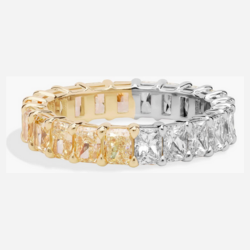
|
| Click On The Image To See The Luxury Shine Of These Vibrant Yellow Diamonds |
Yellow sapphires, though slightly softer, are more resistant to fracturing due to their superior toughness.
If you lead an active lifestyle, considering both hardness and toughness will help you choose a gemstone that withstands daily wear.
Best Jewelry Types for Each Gemstone
The hardness of a gemstone influences how well it performs in different types of jewelry. Yellow diamonds are excellent choices for engagement rings, wedding bands, and bracelets, where they are constantly exposed to friction and impact. Their superior scratch resistance means they maintain their polish and brilliance over time.
Yellow sapphires, while also durable, are better suited for pendants, earrings, and cocktail rings—pieces that experience less frequent rough contact. If choosing a sapphire for a daily-wear ring, a protective setting like a bezel or flush mount can help preserve its surface.
The Role of Proper Care and Maintenance
Even the hardest gemstones require maintenance to keep their sparkle. Diamonds attract oils and grime, which can dull their brilliance if not cleaned regularly. A simple soak in warm, soapy water followed by a soft brush restores their shine.
Yellow sapphires, being slightly more porous, may accumulate residue over time and benefit from occasional ultrasonic cleaning. Ultrasonic cleaning should be done by experts (or under expert guidance) as it is destructive because of the vibrations.
Avoid exposing both gemstones to extreme heat or sudden temperature changes, as thermal shock can cause internal stress fractures.
Balancing Hardness, Style, and Budget
Choosing between yellow diamonds and yellow sapphires isn’t just about durability—it’s also about style and budget.
If you prioritize long-term brilliance with minimal upkeep, a yellow diamond is an unbeatable choice.
If you want a richly colored gemstone at a more accessible price, a yellow sapphire offers beauty with durability.
Both gemstones have their strengths, and the right choice depends on how you plan to wear and care for your jewelry.
|
|
2.b) Understanding The Color Intensity And HueBack To Top |
Color is the soul of a gemstone. Yellow color sapphires offer a spectrum from pale lemon to deep gold. Their warmth can light up any piece of jewelry. Yellow diamonds? They’re like a burst of sunlight—bright and vivid. The intensity of their color can vary, with the most prized being a rich, canary yellow. When selecting your yellow gem, consider the mood you want to set. Is it a gentle sunrise or the bold midday sun?
How Color Saturation Affects Value
The depth and purity of a gemstone’s yellow hue play a major role in its value. In yellow sapphires, color is influenced by the presence of trace elements like iron. The most desirable sapphires exhibit a well-saturated, evenly distributed golden hue without green or brown overtones.
| Yellow and White Diamond Dome Pave Ring in 18k White and Yellow Gold |
|---|
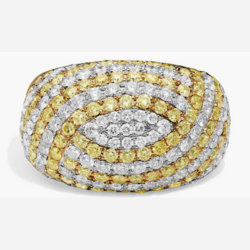
|
| Click On The Image To Click Here To Explore This Stunning White and Yellow Diamond Masterpiece |
Yellow diamonds, on the other hand, get their color from nitrogen atoms within their crystal structure. A higher concentration of nitrogen produces intense yellow tones, which are graded from fancy light to fancy vivid. The richer and more saturated the yellow, the rarer and more valuable the diamond.
The Role of Lighting in Color Perception
Lighting conditions dramatically impact how a gemstone’s color appears. Natural daylight brings out the true hue of yellow diamonds and sapphires, allowing you to see their undertones more clearly. Under warm indoor lighting, yellow sapphires may appear deeper and richer, while yellow diamonds maintain their brilliance but may exhibit slight variations in tone.
If choosing a yellow gemstone for an engagement ring or heirloom piece, viewing it in multiple lighting environments ensures you select the most flattering shade.
How Cut Influences Color Intensity
The way a gemstone is cut directly affects how its color is displayed. Yellow sapphires are often cut with deeper pavilions to enhance color saturation, ensuring that light is absorbed and reflected optimally. Yellow diamonds, particularly those in fancy shapes like cushion or radiant cuts, can intensify color by retaining more depth in their facets.
However, a well-cut round brilliant can also showcase a yellow diamond’s hue beautifully. While round brilliants maximize brilliance and fire, if the diamond has evenly distributed color, this classic cut can still highlight its richness in a dazzling way.
The key is to choose a high-quality cut that balances color intensity with brilliance, ensuring the stone looks its best from every angle.
Matching Yellow Gemstones to Skin Tone and Metal Choices
A gemstone’s color can either complement or contrast with your skin tone and jewelry metal. Cooler, pale yellow sapphires look stunning against fair skin and pair well with white gold or platinum.
Deeper golden yellow sapphires and intense yellow diamonds create a striking contrast on warmer skin tones and are enhanced by yellow gold.
If you want a modern, high-contrast look, a vivid yellow diamond set in a white metal setting provides a bold, radiant effect.
Choosing Between Subtle and Bold Tones
The choice between yellow sapphire and yellow diamond ultimately comes down to the look you want to achieve. If you prefer soft, warm hues with a timeless feel, a yellow sapphire offers classic elegance with consistent color.
If you want a gemstone that radiates intense brilliance and demands attention, a fancy vivid yellow diamond delivers unmatched vibrancy.
Whether you choose the gentle glow of sapphire or the electric energy of a diamond, both stones bring unique beauty to any jewelry collection.
|
|
2.c) Finding The Perfect Yellow StoneBack To Top |
The hunt for the perfect yellow stone is a personal adventure. Yellow sapphires come in various shades and sizes, often at a more accessible price point. They’re versatile—fitting your whims, whether it’s a subtle accent or a bold centerpiece. Yellow diamonds are rarer treasures than yellow sapphires. They speak luxury and are often the choice for those looking to make a statement. As you explore, consider what speaks to you: the understated elegance of sapphire or the dazzling rarity of diamond.
Key Factors in Choosing Your Yellow Gemstone
When searching for the perfect yellow gemstone, trust your instincts and preferences. Color intensity, carat size, and clarity all influence the final look, but the most important factor is how the stone makes you feel. A deep golden sapphire exudes warmth and tradition, while a bright canary diamond offers unmatched brilliance and prestige. Whether you prioritize affordability, rarity, or symbolic meaning, selecting the right yellow gem ensures a timeless piece that reflects your style.
|
|
2.d) Considering The Carat Weight And Value For Lemon Sapphire And Canary DiamondBack To Top |
Carat weight and value are like a seesaw. As the carat goes up, so does the value—but the rise isn’t equal for all gems. Yellow sapphires offer a more forgiving climb in price with size, which means going big won’t necessarily mean going broke. Yellow diamonds, on the other hand, can see their value jump quite sharply with each increase in carat. They’re investment pieces. So, when weighing your options, think about the statement you want to make and what it’s worth to you.
Striking the Right Balance Between Size and Quality
Bigger doesn’t always mean better. A well-cut, intensely colored yellow sapphire can outshine a larger but paler stone. The same goes for yellow diamonds—vivid saturation often matters more than sheer carat weight. When choosing between size and quality, consider what stands out more in your jewelry piece: impressive dimensions or exceptional color brilliance.
|
|
2.e) Expert Advice From Gemologists And Jewelers On Selecting Between Canary Diamonds And Sunshine SapphiresBack To Top |
Lastly, don’t go it alone. Gemologists and jewelers have the scoop, and they love to share it. They can guide you on the subtleties of color, cut, and clarity that make each stone unique. They’ll consider your style, the wearability for your lifestyle, and, of course, your budget. Their insights can help ensure that your choice—the sunny sapphire or the dazzling diamond—will bring lasting joy and sparkle to your life.
Why Professional Guidance Matters
While researching online provides useful knowledge, nothing compares to seeing gemstones in person with expert guidance. Viewing stones under different lighting helps you assess color accuracy, brilliance, and clarity.
That said, reputable online jewelers like James Allen and Blue Nile offer high-resolution 360° videos and magnified images, allowing you to inspect stones in exceptional detail before purchasing.
If you’re buying online, ensure the seller provides detailed certification, return policies, and customer support to guide you through the selection process.
Certifications and Authenticity Checks
Reputable gemologists provide certification documents verifying a stone’s origin, treatments, and quality. For yellow diamonds, institutions like the Gemological Institute of America (GIA) grade color intensity, clarity, and cut, ensuring transparency in pricing.
Yellow sapphires, often heat-treated to enhance color, should also come with a certification disclosing any enhancements.
Asking for these reports protects your investment and ensures you get exactly what you’re paying for.
Personalized Advice Based on Jewelry Use
A gemologist’s advice isn’t just about quality—it’s also about practicality. If you’re selecting a gemstone for daily wear, they might recommend a yellow diamond for its superior scratch resistance.
If you prefer a larger, more affordable stone, they could guide you toward a high-quality yellow sapphire.
Whether you’re designing an engagement ring, pendant, or heirloom piece, their recommendations help you make a choice that aligns with both your aesthetic preferences and lifestyle needs.
| Feature | Description |
|---|---|
| Durability & Hardness | Highlights how yellow diamonds (Mohs 10) and yellow sapphires (Mohs 9) perform under daily wear. |
| Color & Visual Appeal | Explains the range of color intensity—from pale lemon to deep gold in sapphires and the vivid canary yellow of diamonds—and its impact on aesthetics. |
| Stone Selection | Guides readers on selecting the perfect yellow stone by considering clarity, cut, and overall appeal. |
| Carat Weight & Value | Discusses how carat weight affects the value and rarity, comparing lemon sapphires and canary diamonds. |
| Expert Recommendations | Provides insights from gemologists and jewelers to assist in choosing between canary diamonds and sunshine sapphires. |
|
|
3) Are There Any Specific Considerations For Yellow Diamond And Yellow Sapphire In Jewelry MakingBack To Top |
Yellow diamonds and yellow sapphires require secure settings to protect their brilliance and durability. Prong settings enhance a diamond’s fire, while bezels provide extra security for sapphires. Choosing the right metal, such as yellow gold or platinum, further enhances the gemstone’s color and overall aesthetic.
|
|
3.a) The Process Of Setting Canary Diamond And Lemon Sapphires In JewelryBack To Top |
Setting a yellow sapphire or a canary diamond into jewelry requires a careful touch and an eye for detail. The process begins with choosing the metal that complements the gemstone’s hue. Both stones are pretty hard—diamonds are the hardest known material, and sapphires follow closely behind. As such, we can set both into various metals, including the ever-popular choices of gold and platinum.
Jewelers must consider the gemstone’s cut, ensuring it’s secured in the setting to protect it from potential impacts. Bezel settings can frame yellow sapphires beautifully, while prong settings allow yellow diamonds to capture and reflect light spectacularly.
|
|
3.b) Customization And Design OptionsBack To Top |
Customization brings personal stories to life through jewelry. Yellow sapphires, with their range of hues, offer flexibility in design. They can be cut into various shapes and sizes to fit bespoke designs.
Yellow diamonds, particularly the ones with intense color, are often the centerpiece of a design due to their rarity. Designers may create custom pieces highlighting the diamond’s unique features, using accent stones to complement it. Both stones can inspire designs that range from vintage to contemporary, each custom piece reflecting the wearer’s individuality.
|
|
3.c) Comparison Of Yellow Sapphire And Yellow Diamond In Yellow Gold JewelryBack To Top |
Yellow gold provides a rich backdrop that enhances the warm tones of yellow sapphires and diamonds. When set in yellow gold, the sapphires exude a classic, timeless elegance. The gold’s hue brings out the depth of the sapphire’s color.
Yellow diamonds in yellow gold can appear even more vibrant. The gold may intensify the diamond’s color, making it pop. Both stones benefit from the contrast with yellow gold. Still, the choice between them can hinge on whether one prefers the boldness of the diamond or the subtlety of the sapphire.
|
|
3.d) Synthetic Sapphires And Synthetic Diamonds As AlternativesBack To Top |
In today’s market, synthetic alternatives to natural gemstones are gaining popularity. Lab-created yellow sapphires and diamonds offer a more affordable option while still providing the desired color and sparkle. These stones are identical in chemical composition to their natural counterparts, but lab technicians create them in controlled environments.
Synthetic sapphires make bright, durable stones for jewelry at a fraction of the cost. Colored lab diamonds, while more expensive than synthetic sapphires, offer the luxury of a diamond without the high environmental or financial cost of natural diamonds.
|
|
3.e) Wearing And Maintaining JewelryBack To Top |
The lasting beauty of yellow sapphire and yellow diamond jewelry depends on proper care. Both stones are durable, but they still require maintenance. Regular cleaning with mild soap and warm water will keep them shining. It’s important to avoid harsh chemicals or abrasive materials that can damage the stone or its setting. For sapphires, it’s wise to have them checked by a jeweler occasionally, as they can chip or become loose in their settings. Canary diamond may suffer from blunt force, so avoid activities that may expose the jewelry to hard knocks. With mindful wearing and routine care, sapphires and diamonds can maintain their luster for generations.
| Feature | Description |
|---|---|
| Setting Techniques | Describes the process of setting canary diamonds and lemon sapphires to create secure, visually appealing jewelry. |
| Customization & Design | Explores various design options and customization ideas to enhance the beauty of yellow diamonds and sapphires. |
| Comparison in Yellow Gold | Compares the performance and aesthetic impact of yellow sapphires versus yellow diamonds when set in yellow gold. |
| Synthetic Alternatives | Evaluates synthetic sunshine sapphires and canary diamonds as viable alternatives to their natural counterparts. |
| Maintenance & Care | Provides advice on wearing and maintaining jewelry to ensure the longevity and sustained brilliance of yellow gemstones. |
|
|
4) What Are The Gemological And Industry Aspects To Consider Between Yellow Sapphire And Yellow DiamondBack To Top |
Yellow diamonds and yellow sapphires differ in rarity, grading, and market value. The Gemological Institute of America (GIA) grades diamonds based on the 4Cs, with color intensity being crucial for fancy yellow diamonds. Yellow sapphires, assessed mainly by hue and clarity, offer a more accessible price point while maintaining durability and brilliance.
|
|
4.a) Expert Insights From The Gemological Institute Of AmericaBack To Top |
The Gemological Institute of America (GIA) provides a wealth of knowledge on yellow sapphires and diamonds. According to the GIA, jewelry lovers prize yellow sapphires for their durability and affordability. They offer a rich spectrum of hues, from pale to vivid golden. The GIA grades sapphires based on color, clarity, cut, and carat weight, with color being the most critical factor.
On the other hand, GIA assesses yellow diamonds with a specialized grading system that considers the diamond’s color intensity, which ranges from light to fancy deep or fancy vivid. The lab also subjects the diamonds to the standard 4Cs evaluation of diamonds (color, clarity, cut, and carat weight). Both stones have unique optical qualities, with yellow diamonds reflecting light in a way that maximizes brilliance and fire. In contrast, yellow sapphires offer a more subdued, velvety glow.
|
|
4.b) Understanding The Perceived Value And Cost DifferencesBack To Top |
Regarding value and cost, yellow diamonds and sapphires sit on different ladder rungs. Yellow sapphires are generally more affordable, with prices that increase linearly with size and quality. They provide a cost-effective option for those desiring the sunny hues of without the steep diamond price tag.
Yellow diamonds, conversely, are expensive than yellow sapphires, especially those with intense, vivid colors. The rarity of these diamonds elevates their value significantly. The cost of canary diamonds can rise exponentially with size and color intensity, making them a luxury investment. Budget-conscious buyers often lean towards sapphires, while those seeking opulence may prefer the exclusivity of an intense yellow diamond.
|
|
4.c) Evaluating The Market Trends And Availability Of Yellow Sapphire And Yellow DiamondBack To Top |
Market trends and availability for yellow sapphires and diamonds are distinct. Yellow sapphires, while rare in nature, are more abundant in the market than yellow diamonds. Advances in mining and enhancements have made them more accessible, satisfying a growing demand for colorful gemstone jewelry.
Canary diamonds, however, are less common and more sought after, particularly in high-end markets. Their availability is limited, and the demand for natural, intensely colored yellow diamonds has increased, often causing prices to spike. So, yellow diamonds are usually more expensive than sapphires. The allure of owning something rare and unique keeps canary diamonds at the forefront of luxury jewelry trends.
|
|
4.d) Comparison In Terms Of Rarity And ExclusivityBack To Top |
Rarity and exclusivity are significant factors when comparing yellow sapphires and diamonds. Yellow sapphires are rare, especially in vivid shades and without treatments, but they are more commonplace than yellow diamonds.
Yellow diamonds come from the rarest colored diamond family, making them highly exclusive. A yellow diamond’s rarity increases with the intensity of its color; for example, a fancy vivid yellow diamond is the find of a lifetime. Collectors and connoisseurs often vie for such stones, which can be a once-in-a-lifetime acquisition. Rarity adds to the mystique and desirability of these gems, making them coveted by those wishing to own a piece of nature’s scarcity.
|
|
4.e) Distinguishing Between Natural And Synthetic Yellow Sapphires And Yellow DiamondsBack To Top |
You should understand the difference between natural and synthetic yellow sapphires and diamonds as this knowledge is crucial in the jewelry industry. We value natural yellow sapphires mined from the earth for their natural beauty and geological rarity. Synthetic sapphires, while chemically similar, are manufactured and less valuable.
The same holds for yellow diamonds; natural yellow diamonds are formed over billions of years under high pressure and temperatures, making them incredibly rare and valuable. Synthetic diamonds, created in labs, have the same properties but lack the unique history of their natural counterparts. It’s essential to rely on reputable sources and certification from institutes like the GIA to ensure the authenticity of these precious stones.
Section Summary
| Attribute | Yellow Diamond | Yellow Sapphire |
|---|---|---|
| Physical Properties |
|
|
| Chemical Properties |
|
|
| Price Range |
|
|
| Type of Jewelry |
|
|
| Availability in Nature |
|
|
| Lab-Created vs Natural |
|
|
Or See More Similar Looking Gemstones As Follows:
| Blue Sapphire or Tanzanite | Ruby or Red Garnet |
| Ruby or Pink Sapphire | Orange Sapphire or Citrine |
